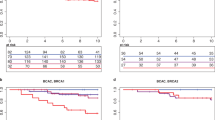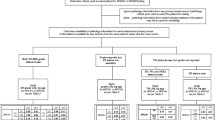Abstract
The BRCAPRO model estimates carrier probabilities for the BRCA1 and BRCA2 genes, and was recently enhanced to use estrogen receptor (ER) and progesterone receptor (PR) status of breast cancer. No independent assessment of the added value of these markers exists. Moreover, earlier versions of BRCAPRO did not use human epidermal growth factor receptor 2 (Her-2/neu) status of breast cancer. Here, we incorporate Her-2/neu in BRCAPRO and validate all the markers. We trained the enhanced model on 406 germline tested individuals, and validated on a separate clinical cohort of 796 individuals for whom test results and family history are available. For model-building, we estimated joint probabilities of ER, PR, and Her-2/neu status for carriers and non-carriers of BRCA1/2 mutations. For validation, we obtained BRCAPRO predictions with and without markers. We calculated area under the receiver operating characteristic curve (AUC), sensitivity, specificity, predictive values, and correct reclassification rates. The AUC for predicting BRCA1 status among individuals who are carriers of at least one mutation improved when ER and PR were used. The AUC for predicting the presence of either mutation improved when Her-2/neu was added. Use of markers also produced highly significant correct reclassification improvements in both cases. Breast tumor markers are useful for prediction of BRCA1/2 mutation status. ER and PR improve discrimination between BRCA1 and BRCA2 mutation carriers while Her-2/neu helps discriminate between carriers and non-carriers, particularly among women who are ER positive and Her-2/neu negative. These results support the use of the enhanced version of BRCAPRO in clinical settings.



Similar content being viewed by others
Abbreviations
- AJ:
-
Ashkenazi Jewish
- AUC:
-
Area under the ROC curve
- CI:
-
Confidence interval
- CK:
-
Cytokeratin
- ER:
-
Estrogen receptor
- FISH:
-
Fluorescence in situ hybridization
- Her-2/neu:
-
Human epidermal growth factor receptor 2
- IHC:
-
Immunohistochemistry
- IDI:
-
Integrated discrimination improvement
- MDACC:
-
MD Anderson Cancer Center
- NRI:
-
Net reclassification improvement
- PR:
-
Progesterone receptor
- PVN:
-
Predictive value negative
- PVP:
-
Predictive value positive
References
Antoniou A, Pharoah PD, Narod S et al (2003) Average risks of breast and ovarian cancer associated with BRCA1 or BRCA2 mutations detected in case Series unselected for family history: a combined analysis of 22 studies. Am J Hum Genet 72:1117–1130
King MC, Marks JH, Mandell JB (2003) Breast and ovarian cancer risks due to inherited mutations in BRCA1 and BRCA2. Science 302:643–646
Chen S, Wang W, Broman KW et al (2004) BayesMendel: an R environment for Mendelian risk prediction. Stat Appl Genet Mol Biol 3:21
Parmigiani G, Berry D, Aguilar O (1998) Determining carrier probabilities for breast cancer-susceptibility genes BRCA1 and BRCA2. Am J Hum Genet 62:145–158
James PA, Doherty R, Harris M et al (2006) Optimal selection of individuals for BRCA mutation testing: a comparison of available methods. J Clin Oncol 24:707–715
Parmigiani G, Chen S, Iversen ES et al (2007) Validity of models for predicting BRCA1 and BRCA2 mutations. Ann Intern Med 147:441–450
Barcenas CH, Hosain GM, Arun B et al (2006) Assessing BRCA carrier probabilities in extended families. J Clin Oncol 24:354–360
Marroni F, Aretini P, D’Andrea E et al (2004) Evaluation of widely used models for predicting BRCA1 and BRCA2 mutations. J Med Genet 41:278–285
Lindor NM, Lindor RA, Apicella C et al (2007) Predicting BRCA1 and BRCA2 gene mutation carriers: comparison of LAMBDA, BRCAPRO, Myriad II, and modified Couch models. Fam Cancer 6:473–482
Euhus DM, Smith KC, Robinson L et al (2002) Pretest prediction of BRCA1 or BRCA2 mutation by risk counselors and the computer model BRCAPRO. J Natl Cancer Inst 94:844–851
Kang HH, Williams R, Leary J et al (2006) Evaluation of models to predict BRCA germline mutations. Br J Cancer 95:914–920
Tai YC, Chen S, Parmigiani G et al (2008) Incorporating tumor immunohistochemical markers in BRCA1 and BRCA2 carrier prediction. Breast Cancer Res 10:401
Katki HA, Blackford A, Chen S et al (2008) Multiple diseases in carrier probability estimation: accounting for surviving all cancers other than breast and ovary in BRCAPRO. Stat Med 27:4532–4548
Katki HA (2007) Incorporating medical interventions into Mendelian mutation prediction models. BMC Med Genet 8:13
Chen S, Blackford AL, Parmigiani G (2009) Tailoring BRCAPRO to Asian-Americans. J Clin Oncol 27:642–643
Lakhani SR, Van De Vijver MJ, Jacquemier J et al (2002) The pathology of familial breast cancer: predictive value of immunohistochemical markers estrogen receptor, progesterone receptor, HER-2, and p53 in patients with mutations in BRCA1 and BRCA2. J Clin Oncol 20:2310–2318
Lakhani SR, Reis-Filho JS, Fulford L et al (2005) Prediction of BRCA1 status in patients with breast cancer using estrogen receptor and basal phenotype. Clin Cancer Res 11:5175–5180
Atchley DP, Albarracin CT, Lopez A et al (2008) Clinical and pathologic characteristics of patients with BRCA-positive and BRCA-negative breast cancer. J Clin Oncol 26:4282–4288
Parmigiani G (2002) Modeling in medical decision making. Wiley, Chichester
DerSimonian R, Laird N (1986) Meta-analysis in clinical trials. Control Clin Trials 7:177–188
Efron B, Tibshirani R (1994) An introduction to the bootstrap. Chapman and Hall/CRC Monographs
Cook NR, Buring JE, Ridker PM (2006) The effect of including C-reactive protein in cardiovascular risk prediction models for women. Ann Intern Med 145:21–29
Pencina MJ, D’Agostino RB, D’Agostino RB (2008) Evaluating the added predictive ability of a new marker: from area under the ROC curve to reclassification and beyond. Stat Med 27:157–172
Pencina MJ, D’Agostino RB, Steyerberg EW (2011) Extensions of net reclassification improvement calculations to measure usefulness of new biomarkers. Stat Med 30:11–21
Mavaddat N, Rebbeck TR, Lakhani SR et al (2010) Incorporating tumour pathology information into breast cancer risk prediction algorithms. Breast Cancer Res 12:R28
Acknowledgments
This study was supported in part by the Susan G Komen for the Cure Grant KG081303, an Intramural Seed Grant from the University of North Texas Health Science Center, and the Program in Human and Computational Genomics at MDACC.
Conflict of interest
All authors declare that they have no conflict of interest.
Author information
Authors and Affiliations
Corresponding author
Additional information
Giovanni Parmigiani and Banu Arun have contributed equally to this study.
Rights and permissions
About this article
Cite this article
Biswas, S., Tankhiwale, N., Blackford, A. et al. Assessing the added value of breast tumor markers in genetic risk prediction model BRCAPRO. Breast Cancer Res Treat 133, 347–355 (2012). https://doi.org/10.1007/s10549-012-1958-z
Received:
Accepted:
Published:
Issue Date:
DOI: https://doi.org/10.1007/s10549-012-1958-z




